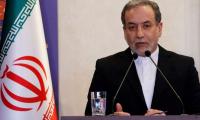There is confusion over who our enemies are. The narrative pushed forward by the military since Operation Zarb-e-Azb began in 2014 suggests that the extremists and those promoting hatred constitute the real threat to our security and need to be hunted down.
The military high command for the first time went so far as to describe these elements as the biggest threat to security faced by the country. This chain of thought was carried forward after the December 2014 massacre at the Army Public School in Peshawar with the approval of the National Action Plan by all major political parties. NAP laid down a series of points to combat hate speech and promote tolerance and harmony in a society where terrorist violence had to be quelled at all costs.
But who truly believed that the militants were the enemy? There is certainly a great deal of confusion over this. In his recent speech in the Senate, Interior Minister Chaudhry Nisar Ali said that outlawed sectarian organisations should not be equated with those of terrorist outfits. The minister also seemed to have made light of sectarian violence by saying that sectarian violence had been continuing for 1,300 years.
Do his words not imply that the odd killing of a few dozen – or even a few hundred – people belonging to another sect is not as bad as militancy? Does this not place a stamp of approval on sectarian forces which have gunned down thousands of people over the years, formed private armies to battle each other and are now engaged in a war which threatens to involve various schools of thought and opinions? When the government and its ministers themselves go against the spirit of NAP, it is easy to see why others would be confused and, perhaps, unable to think clearly on the matter.
Many of these sectarian groups, along with the militant forces with whom they have forged dangerous and deadly alliances, operate pages and sites on the internet on which they put across their damaging and essentially inhumane opinions.
These groups freely call for the killing of others and suggest that those who do not follow a particular line of thought deserve to be murdered. Indeed, calls for the killing of people have been made on the streets of the country as well, with protesters agitating against individuals whom they believe have hurt religious sentiments. They were recently permitted to block roads in Lahore for hours and thereby pushed forward specific ideas through their presence on the streets.
All this coincides with the disappearance of at least five activists who had used the website to promote their own ideas. It cannot be a coincidence that those who went missing in early January were known were harboring views that cannot have endeared them to those who aren’t exactly known for their tolerance for dissent. The missing men were not known for making demands to kill, to maim or to otherwise physically hurt other citizens.
At least one of the activists, Dr Salman Haider, was primarily concerned with the issue of the missing people in Balochistan. He has now joined the ranks of those who have vanished and the fear is that may be experiencing precisely what the many missing people have gone through.
Yes, it is possible that the activists will return. They may either turn up silently at their homes or be found at street corners. Perhaps they will tell their tales, perhaps they will not. But regardless of what happens, the message has been delivered forcefully and without ambiguity. No licence will be permitted to those who put forward a different ideology to make public their thoughts, even if they do so only through small social media networks which reach only a limited number of people.
People who use the internet are, of course, free to decide which sites they visit, what they read or whom they follow on apps, such as Twitter. Many pages run by Baloch nationalists, Sindhi intellectuals and other groups which are found undesirable by those at the helm of power have been closed down one by one since 2002.
Now, it seems the authorities have marched forward a few steps at a rapid pace. They are snatching away the limited room still used by activists who wish to promote ideas that are not wanted in a society where top government officials believe it is acceptable to enter into political deals with extremist groups and defend banned sectarian organisations as legitimate entities.
We can now see which way things are headed. It is also disturbing that the disappearance of the activists has been noted only in minor headlines in the mainstream media. The Urdu media has, in fact, almost entirely omitted mentioning these developments. They were only mentioned because the abductions, kidnappings or whatever the chain of events that took place, occurred in Rawalpindi and other towns of Punjab rather than a more distant place in our country where information has been almost completely blocked out.
We simply do not know what happens in these places or how the affairs are manipulated to suit certain interests, destroy groups which have agitated against the state and mould them into something quite different. The dangers inherent in this have apparently not been recognised even though they represent a terrible threat to the sanctity of our country.
The consequence of the activists’ disappearances will be severe, whether or not they return. Fewer and fewer people will speak out and fewer youngsters or students will attempt to develop social media spaces for themselves. This perhaps is the entire idea behind the action that has been taken. In logical terms, there was no reason to go after the five men who have vanished in what seems like a single swoop. They had limited influence, a limited following and few people were even remotely familiar with their names. Now, of course, many more people are.
The purpose then is to create a state where no one will dare to differ. We are already close to having successfully constructed such a place. Only the final bricks need to be laid so that the gaps can be closed off. This would create an airless atmosphere; an atmosphere that does not permit thinking or the voicing of reason. An environment which stifles those who live within it.
This is the kind of place elements within our society are bent on creating. There are real doubts over whether our political leadership has either the wisdom or the will to combat such forces. There is certainly little evidence that this is the case.
In time, the same forces may come after the political leadership as well. After all, we have been successful in removing elements who do not conform to a particular point of view from our midst. These people include the influential leaders of major parties killed in bombings or gun attacks as well as less prominent local level leaders who influence their own communities. The trend has been continuing for over a decade.
Social media is now also under similar attack. Groups defending the freedom of internet space have spoken out against it many times. Their voices have been ignored. The provisions laid down under NAP, particularly those involving crackdowns against hate speech, have been ignored as well and the combination makes for a terribly dangerous state of affairs.
The writer is a freelance columnist and former newspaper editor.
Email: kamilahyat@hotmail.com
US must ditch tariff fetish, rally its allies and sit down with China to salvage trade before floor caves in
Only through establishment of hard state can Pakistan secure its future and ensure justice, security
Invention of Bakelite by Belgian chemist Leo Baekeland in 1907 marked beginning of large-scale plastic production
It was found that at least 60% of answers given by AI were inaccurate or blatantly incorrect
Apple and other manufacturing giants face skyrocketing costs as their China-based supply chains get taxed into oblivion
Pakistani mills buy American cotton, turn it into products, and sell those goods back to American consumers







